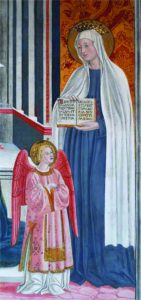March Saint – St Frances of Rome

by Fr Merv Duffy SM

St Frances of Rome
Image from Eman Bonnici
St Frances of Rome -9 March
Francesca Busso was a 'Roman of Rome', one who lived her whole life in the Eternal City. She was born in the house of a noble family on the famous Piazza Navona in 1384. She took her faith seriously from an early age, and was a prayerful, pious child. She declared that she wanted to enter a convent, but her family had other plans. At that period, and for much of history, marriages were arranged by families. The interests of the family guided the decisions, though these included the good of the marriageable daughter. At age twelve, Frances was married to a rich nobleman, Lorenzo Ponziani, who was the commander of the Pope’s armsmen. It proved to be a loving marriage that lasted for forty years.
Marrying Lorenzo meant leaving her family and moving into the Palazzo Ponziani, which was managed by Lorenzo’s mother, Cecelia. Frances found this hard. Her mother-in-law wanted her to act as a high-society wife, attending social events dressed in style. Frances wanted to pray and to help the poor. She found a friend and supporter in Vanozza, the wife of her husband’s older brother. Perhaps the two women, both having married into the family, bonded through being ‘on the outer’ together. They used to go to visit the sick in the nearby hospital of Santo Spirito. Frances must, however, have shown herself competent in household management because, when Cecelia died, Lorenzo’s father appointed Frances to take charge of the family home, despite her arguing that Vanozza had seniority.
Frances had to find a balance between her religiosity and the demands of being a wife, household manager and, eventually, the mother of six children. She maintained a regular prayer life but considered that to be secondary to her other duties. She is quoted as saying: “A married woman must leave all her devotions when the household demands it.” One day while she was praying the Little Hours of the Blessed Virgin, she was called away four times just as she got to a particular verse of the psalm. When she returned to her prayer the final time, she found that verse written in gold, which she took as a sign that God approved of her obedience to her duties. She and Vanozza wanted to sell their jewelry to help the hospital, but her confessor advised her against it, telling her that they must avoid “singularity” and “must dress in a style suitable to their rank.”
Frances and Vanozza gained a reputation for their piety, charity, and care of the sick, both in the hospital of Santo Spirito and in their homes. During a plague they fed invalids from the household stores of Palazzo Ponziani and when these ran out, they begged for more food from other noble families, and, finally, sold their own jewels to pay for food supplies.
When Frances was 24 years of age, in 1408, Rome was invaded by the army of Naples, Lorenzo and his troops were defeated, he was banished, their estates confiscated, and their palazzo sacked. Frances maintained what was left of their household in a corner of their ruined home. Within a few years peace was restored, Lorenzo allowed to return, and their property restored. Unfortunately, Lorenzo’s health had been ruined, and from then on Frances cared for him in the family home.
Frances and Lorenzo had six children, but we know the names of only three. Battista who succeeded Lorenzo as head of the family. Evangelista who died of the plague in 1411 and Agnes who died in 1413. Evangelista is said to have foretold his own death and that of his sister. He also said that after Agnes died, Frances, and only Frances, would be able to see her own guardian angel. This accorded with her reputation for holiness and legends arose about Frances and her guardian angel, how he would light the street for her as she came home late at night after visiting the sick, and how he would fade from her sight if she committed a fault. When St Francesca Romana is depicted in art, her attribute is the guardian angel at her side.
Lorenzo had been keen for Battista to marry, but the bride he chose for him, Mabilia, proved to be something of a trial to the family. Frances expected Mabilia to help in the management of the household, but Mabilia was only interested in partying and she ridiculed Frances’s style of dress, piety and concern for the poor. They clashed repeatedly, but when Mabilia fell ill, Frances nursed her back to health with such kindness that she quite won her over.
Frances had developed a reputation for personal holiness, mystical visions, and concern for the poor. Other noble women wanted to associate with her and Vanozza in their work. In 1425, Frances founded a group of Oblates of Olivetan Benedictines attached to the church of Santa Maria Nuova. (“New St Mary’s” - There had been a church there since the tenth century, but there was an older St Mary’s church in the Forum, logically enough, referred to as Santa Maria Antiqua “Old St Mary’s”).
The oblates initially only worked together, but after a few years they re-organised to live in community to facilitate their work and prayer. Their constitution was approved by Pope Eugene IV in 1433. They continue to this day in this one and only community of the congregation.
Lorenzo died about 1436. His last words to her are reported as “I feel as if my whole life has been one beautiful dream of purest happiness. God has given me so much in your love.” Frances retired among her oblates, who promptly made her their superior. She died in 1440 and her reputed last words were: “The angel has finished his task – he beckons me to follow him”
Frances is the patron saint of the housewives of Rome, of widows and, (because of the guardian angel) of motorists.

Santa Maria Nova – now known as the basilica of Santa Francesca Romana
By Jean-Pol GRANDMONT - Own work, CC BY 4.0, https://commons.wikimedia.org/w/index.php?curid=85065944
Lorenzo had been keen for Battista to marry, but the bride he chose for him, Mabilia, proved to be something of a trial to the family. Frances expected Mabilia to help in the management of the household, but Mabilia was only interested in partying and she ridiculed Frances’s style of dress, piety and concern for the poor. They clashed repeatedly, but when Mabilia fell ill, Frances nursed her back to health with such kindness that she quite won her over.
Frances had developed a reputation for personal holiness, mystical visions, and concern for the poor. Other noble women wanted to associate with her and Vanozza in their work. In 1425, Frances founded a group of Oblates of Olivetan Benedictines attached to the church of Santa Maria Nuova. (“New St Mary’s” - There had been a church there since the tenth century, but there was an older St Mary’s church in the Forum, logically enough, referred to as Santa Maria Antiqua “Old St Mary’s”).
The oblates initially only worked together, but after a few years they re-organised to live in community to facilitate their work and prayer. Their constitution was approved by Pope Eugene IV in 1433. They continue to this day in this one and only community of the congregation.
Lorenzo died about 1436. His last words to her are reported as “I feel as if my whole life has been one beautiful dream of purest happiness. God has given me so much in your love.” Frances retired among her oblates, who promptly made her their superior. She died in 1440 and her reputed last words were: “The angel has finished his task – he beckons me to follow him”
Frances is the patron saint of the housewives of Rome, of widows and, (because of the guardian angel) of motorists.
 Entries(RSS)
Entries(RSS)